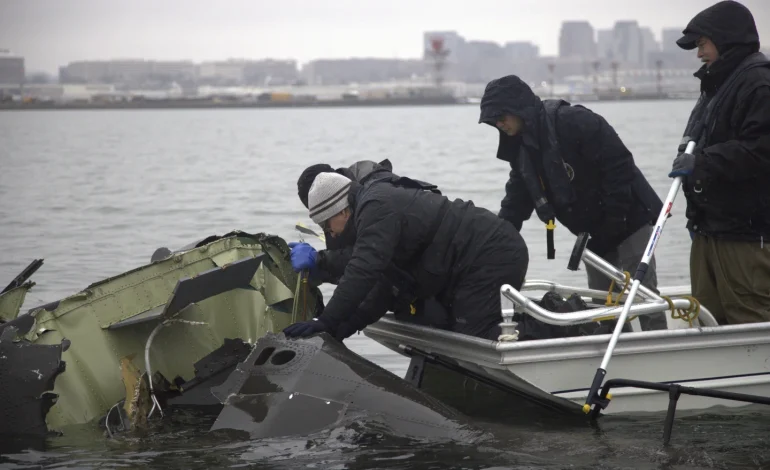Grief-stricken families of the 67 victims of Wednesday’s devastating mid-air collision over the Potomac River visited the crash site as recovery teams worked tirelessly to locate and identify all remains, The Associated Press reports.
The collision between an American Airlines jet and an Army Black Hawk helicopter is the deadliest US air disaster since 2001.
So far, authorities have recovered and identified 55 of the 67 victims. Divers are carefully navigating the submerged wreckage, while crews prepare to lift the debris from the chilly waters of the Potomac River as early as Monday morning.
Divers, equipped with high-definition cameras monitored on support boats, are adhering to strict protocols, halting debris removal immediately upon the discovery of any remains. The frigid conditions have taken a toll, with one diver treated for hypothermia.
The wreckage of the two aircraft will be loaded onto flatbed trucks and transported to a hangar for investigation. The American Airlines jet, carrying 64 people, was en route from Wichita, Kansas, preparing to land at Reagan Washington National Airport. The Black Hawk helicopter, with three service members on board, was engaged in a training mission. There were no survivors.
Federal investigators from the National Transportation Safety Board (NTSB) are meticulously piecing together the events that led to the catastrophic collision. The NTSB did not hold a press conference on Sunday, but released photos of investigators examining the wreckage and a flight data recorder. Transportation Secretary Sean Duffy emphasized the need to allow investigators the space to conduct their inquiry, but did acknowledge questions remain about the circumstances of the incident.
The victims on the Black Hawk helicopter were identified as Army Staff Sgt. Ryan Austin O’Hara, 28, of Lilburn, Georgia; Chief Warrant Officer 2 Andrew Loyd Eaves, 39, of Great Mills, Maryland; and Capt. Rebecca M. Lobach, of Durham, North Carolina. The passengers on the American Airlines jet included figure skaters returning from the 2025 US Figure Skating Championships in Wichita and a group of hunters returning from a guided trip.
Preliminary data from the NTSB revealed conflicting readings about the altitudes of the two aircraft. The jet’s flight recorder showed a change in pitch about a second before impact, though it’s unclear whether this was an attempted evasive maneuver. Data from the jet’s black box indicated an altitude of 325 feet, plus or minus 25 feet, at the time of the collision. However, data from the air traffic control tower placed the Black Hawk at 200 feet, the maximum authorized altitude for helicopters in the area. Investigators are working to reconcile these discrepancies.
The investigation will also consider air traffic control procedures. According to an FAA report, at the time of the incident, a single controller was responsible for both helicopter and plane traffic, a task usually divided between two controllers. While this combination is routine at 9:30 PM, when traffic slows, on Wednesday, the supervisor combined them earlier, which the report called “not normal.”
This tragedy comes amid a week of heightened anxiety in US air travel. On Friday, an air ambulance crashed in Philadelphia, killing six people, including a child. Also on Friday, the FAA heavily restricted helicopter traffic around Reagan Airport after concerns were raised on social media about a helicopter flying at an unauthorized altitude. Experts stress that air travel is overw helmingly safe, but the crowded airspace around Reagan Airport can be challenging for even experienced pilots.
The investigation into the mid-air collision is expected to be thorough and may take a year or more to complete, although a preliminary report is anticipated within 30 days.








